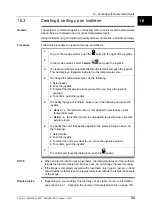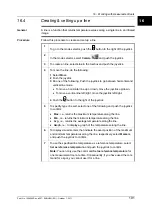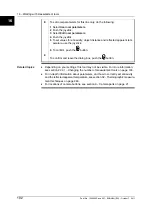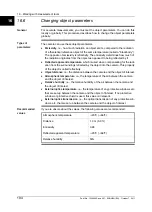
18.2
Building alarms
General
The camera features alarm types that are specific to the building trade. You can make
the camera trigger the following types of alarms:
■
Dewpoint
alarm: Triggers when a measurement tool detects a cold surface where
there is risk of humidity falling out as liquid water.
■
Relative humidity
alarm: Triggers when a measurement tool detects a surface
where the relative humidity exceeds a preset value.
■
Insulation
alarm: Triggers when there is an insulation deficiency in a wall.
About the
Dewpoint alarm
Dewpoint can be regarded as the temperature at which the humidity in a certain
volume of air will condense as liquid water. At this point, the relative humidity is 100%.
When you have set a number of environmental parameters, the
Dewpoint
alarm can
detect these areas and warn you that there may be a deficiency in the building
structure.
About the Relative
humidity alarm
In some situations, mold will grow on areas where the relative humidity is less than
100%. To detect those areas, the dewpoint alarm can not be used, since it only detects
areas where there is risk of humidity falling out as liquid water, i.e., where the relative
humidity is 100%.
To detect areas where the relative humidity is less than 100% you can use the
Relative
humidity
alarm, where you can set the relative humidity above which the alarm will
trigger.
About the
Insulation alarm
The
Insulation
alarm can detect areas where there may be an insulation deficiency
in the building. It will trigger when the insulation level falls below a preset value of
the energy leakage through the wall.
Different building codes recommend different values, but typical values are 0.6–0.8
for new buildings. Refer to your national building code for recommendations.
About the Area
coverage
parameter
This factor sets the severity threshold for the alarm. It defines the size of the area in
the image that must detect the condition set up by the alarm.
Alarm signals
When an alarm is triggered, the alarm signal can be one of the following:
■
An audible alarm signal (a ‘beep’)
■
A visible alarm signal (an isotherm)
Procedure
Follow this procedure to set up an alarm:
To go to the mode selector, push the
button to the right of the joystick.
1
In the mode selector, select
Camera
and push the joystick.
2
18
Publ. No. 1558550 Rev. a557 – ENGLISH (EN) – October 7, 2011
113
18 – Working with alarms
Summary of Contents for B6 series
Page 2: ......
Page 4: ......
Page 6: ......
Page 8: ......
Page 9: ...User s manual Publ No 1558550 Rev a557 ENGLISH EN October 7 2011...
Page 12: ...INTENTIONALLY LEFT BLANK xii Publ No 1558550 Rev a557 ENGLISH EN October 7 2011...
Page 192: ...it 26 174 Publ No 1558550 Rev a557 ENGLISH EN October 7 2011 26 Dimensional drawings...
Page 325: ......
















































